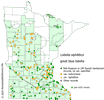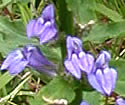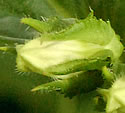Lobelia siphilitica (Blue Lobelia)
| Also known as: | Great Blue Lobelia, Blue Cardinal Flower |
|---|---|
| Genus: | Lobelia |
| Family: | Lobeliaceae (Lobelia) |
| Life cycle: | perennial |
| Origin: | native |
| Habitat: | part shade, sun; moist fields, along shores |
| Bloom season: | July - October |
| Plant height: | 1 to 4 feet |
| Wetland Indicator Status: | GP: OBL MW: OBL NCNE: FACW |
| MN county distribution (click map to enlarge): |  |
| National distribution (click map to enlarge): |  |
Pick an image for a larger view. See the glossary for icon descriptions.
Detailed Information
Flower: 



![[photo of flowers]](/udata/r9ndp23q/pd/lobelia-siphilitica-342-2-t.jpg) Elongating spike-like raceme of irregular tubular flowers about 1 inch long on a short flower stalk, with a leafy bract at base of the stalk. Color ranges from light blue to bright blue-violet. Flowers have 3 pointed lobes below and 2 smaller lobes above, sometimes erect but usually curved back. In between the upper lobes is a curved style. The lower center lobe has 2 small bumps near the throat, with a spot of white at the top of the bump, and white stripes on the outside of the throat. The calyx holding the flower has long narrow lobes, sometimes with long hairs around the edges. Leafy bracts become smaller as they ascend the stem. The cluster is typically densely packed at the top and a bit looser towards the bottom, with flowers blooming from the bottom up
Elongating spike-like raceme of irregular tubular flowers about 1 inch long on a short flower stalk, with a leafy bract at base of the stalk. Color ranges from light blue to bright blue-violet. Flowers have 3 pointed lobes below and 2 smaller lobes above, sometimes erect but usually curved back. In between the upper lobes is a curved style. The lower center lobe has 2 small bumps near the throat, with a spot of white at the top of the bump, and white stripes on the outside of the throat. The calyx holding the flower has long narrow lobes, sometimes with long hairs around the edges. Leafy bracts become smaller as they ascend the stem. The cluster is typically densely packed at the top and a bit looser towards the bottom, with flowers blooming from the bottom up
Leaves and stem: 

![[photo of leaves]](/udata/r9ndp23q/blue/blue-lobelia_0827_112214-t.jpg) Leaves are 2 to 6 inches long and up to 2 inches wide, irregularly toothed, hairless or sparsely hairy, pointed at the tip, alternately attached with no leaf stalk. Shape is somewhat variable and may be elliptical, lance-like or only slightly narrowed toward the base. The stem is unbranched, ridged, and may have short hairs scattered along the ridges.
Leaves are 2 to 6 inches long and up to 2 inches wide, irregularly toothed, hairless or sparsely hairy, pointed at the tip, alternately attached with no leaf stalk. Shape is somewhat variable and may be elliptical, lance-like or only slightly narrowed toward the base. The stem is unbranched, ridged, and may have short hairs scattered along the ridges.
Fruit: 
![[photo of seed]](/udata/r9ndp23q/pd/lobelia-siphilitica-seed-t.jpg) Fruit is a small 2-chambered capsule, each chamber containing many tiny, oval, semi-translucent golden brown seeds. Seeds are densely covered in a network of fine ridges and many shiny scale-like appendages, almost like shingles. The photo doesn't do them justice. :-)
Fruit is a small 2-chambered capsule, each chamber containing many tiny, oval, semi-translucent golden brown seeds. Seeds are densely covered in a network of fine ridges and many shiny scale-like appendages, almost like shingles. The photo doesn't do them justice. :-)
Notes:
Blue Lobelia makes a great garden plant—butterflies love it. It is doing quite well in my own poorly drained clay soil in full sun, blooming most of the summer through early fall. The Lobelia genus was once in its own Lobeliaceae family, then was moved to the Campanulaceae (Bellflower) family but is now back in Lobeliaceae. There are 2 varieties, both found in Minnesota. Var. siphilitica is an eastern species where Minnesota is on the western edge of the range; it has leaves typically at least ¾ inch wide, 20 or more flowers in the cluster, and is hairy to varying degrees. Var. ludoviciana is a western species where Minnesota is on the eastern edge of the range; its leaves are less than ¾ inch wide, typically has 6 to 20 flowers, and is mostly hairless.
Native Plant Nurseries, Restoration and Landscaping Services ↓
More photos
Photos by K. Chayka taken at Long Lake and Rice Creek Regional Parks, Ramsey County. Photos courtesy Peter M. Dziuk taken in Anoka County.
Comments
Have you seen this plant in Minnesota, or have any other comments about it?
on: 2010-08-14 20:40:47
Bought a rocky pasture in 2007 with a small stream cutting through it. Have a big patch of this I noticed today. Blooming, and really nice.
on: 2010-10-05 22:47:17
Blooming on Oct. 4, 2010 in a wet prairie, almost hidden in tall grasses.
on: 2011-08-14 22:40:22
We live on the bluff overlooking Prairie Island, between Hastings & Red Wing. Our property has sandy, well-drained soil, and yet we have a good stand of blue lobelia growing here in the woods. It finished blooming in August 2011.
on: 2011-08-21 16:54:06
Blue Lobelia currently blooming along the lakeshore among Joe-Pye, cattail, and various grasses.
on: 2011-09-16 15:25:25
Photographed this flower today on a walk along Purgatory Creek.
on: 2013-09-30 16:47:06
I found a couple one foot high single blossomed stems growing a few feet from the lake shoreline in damp soil on a path in heavy clay soil 9/30/2013.
on: 2014-09-16 13:59:19
Several in bloom beside the wetland portion of my prairie planting
on: 2015-05-29 01:58:57
It was a delight to see this blooming on the shore of O'Brien Lake in Lebanon Hills Park. Only one I've ever seen in the park.
on: 2015-09-21 22:53:39
I first found blue lobelia in Grundmeyer Wildlife Management Area west of Gibbon. Later I found some at Fort Ridgely State Park next to a small lake in a prairie area. I went on a tour of Seminary Fen Scientific Natural Area (SNA) near Chaska and they were blooming there too.
on: 2017-08-17 22:07:58
Found 5 of these treasures in the corner of an old cow pasture...saw them on a drive by...stopped and took photos...lots of other native good stuff there...these were the closest to being blue that I have ever seen.
on: 2017-08-27 11:17:23
I found ramdom plants in half bloom growing in a third year WREP planting. They do not compete very well with canada thistles.
on: 2017-09-02 08:16:39
We've found several growing along the shoreline of our ponds. They started blooming in August.
on: 2017-09-18 14:14:20
This posture had been treated with Roundup then planted with native prairie species. Lobelia was not one of the forms we planted! but seed bank survived. Beautiful!
on: 2018-08-04 11:18:46
Found it on the bank of a beaver pond.
on: 2018-08-21 22:07:33
Together with Gentiana andrewsii on a sandy shore of the lake.
on: 2018-09-03 12:03:09
Found beautiful clumps of these on Camp Rd. today near E. Burns Valley Rd. between the road and pasture fence in a grassy wet ditch, near Burns Valley Creek. Lovely!
on: 2019-08-24 08:21:28
I found a clump of blue lobelia growing in our pasture and alongside it is one or more similar plants that have pure white flowers. Is the "alba" version native to our area?
on: 2019-08-24 08:31:38
Edward, it is not uncommon to occasionally have a white-flowered specimen in plants that normally have blue, purple or pink flowers. It is a natural variation, not a different (sub)species or var and may or may not be hereditary. We've seen it many times in many different species.
on: 2019-08-29 06:04:58
Went to view a shoreline restoration project on Gull Lake. This was a new one for me and delighted to find it is native. Beautiful and thriving along with many other native plants.
on: 2019-08-29 14:40:27
Found August 29, 2019 in full bloom. Approximately 1.5 - 2ft tall growing in the rain garden of the Red Lake Watershed office building. Beautiful contrast w/ all the coneflower // golden rod // black eyed susans! Planted in 2011.
on: 2019-09-01 16:20:09
Blooming in Lebanon Hills Park, Dakota County. 9/1/18
on: 2019-09-03 17:21:46
Three years ago I planted 4 acres of Minnesota Native pollinator m8x from Albert Lea Seed Co. It has been quite wet this year, and I have a lot of Lobelia siphilitica in the habitat, particularly in the less well drained areas. The bees love it.
on: 2019-09-14 14:06:17
Mowing 2 weeks ago and found 2.5 foot plant along barn, about 6 feet from my Butterfly garden. Tried growing Cardinal Lobelia years ago with no luck. The Blue Lobelia I found must have been a gift from the birds. I marked and flagged it so it wouldn't get pulled. LOVE IT!
on: 2020-08-16 12:57:20
Great Blue Lobelia - began flowering in my yard on August 15. I planted it in my perennial bed many years ago. The bumblebees love it. It seeds itself quite generously.
on: 2020-08-16 15:44:05
Small but robust patch at edge of the Dundas dog park, in full bloom in a wet transitional area between a cattail slough and a gentle rise to the southeast. Associated with blue vervain, swamp milkweed, impatiens/touch-me-not and several sedge species.
on: 2021-08-10 22:48:38
Saw the most brilliant blue/violet lobelia along Wisel Creek while fishing. New flower for me!
on: 2021-08-12 19:28:52
Many blooming now very showy and attracts one's eyes instantly.
on: 2021-08-19 14:14:58
Growing along the shore of Lake Bemidji in Diamond Point Park
on: 2021-08-31 12:01:27
Seen blooming off shoreline of Big Stoney Lake South of Dorset
on: 2021-09-04 22:09:01
Blooming in a wet area near willows at the Morris Wetland Management's Wildlife Trail
on: 2022-09-02 15:16:55
A large patch of approx 40 stems growing by the edge of Long Lake on our property this year.
on: 2022-09-12 09:30:51
Have several acres on my farm in full bloom this weekend.
on: 2022-09-22 18:02:45
There are a few blooming along the Purgatory Creek trail in Eden Prairie. There would have been more but the trail maintenance crew mowed them down. I've been watching bumblebees gather nectar from these, and the bees tend to crawl around the outside of the flower rather than stick their heads inside. They seem to be gathering the nectar through the gaps between the petals. I don't know how that affects pollination because they don't come in contact with the pistil hanging above the flower opening. Maybe smaller insects do the actual pollinating? I don't know.
on: 2022-09-23 16:43:53
Curtis, bumblebees are the only bees strong enough to pry open the flower, so smaller bees aren't effective pollinators. Sometimes, bees will make holes at the base of a flower to get to nectar they otherwise might have a hard time reaching. I know this happens with red columbine and other species.
on: 2023-09-20 11:34:25
A single plant showed up in our nursery plot of Bee Balm this year. We do drip irrigation in this east-facing plot, the soil is refreshed with compost yearly and compost tea monthly. I'm hoping it propagates on its own. The bumblebees are all over it now that the monarda is finished.







 Blue Lobelia plant
Blue Lobelia plant more plants
more plants flower buds with leafy bracts
flower buds with leafy bracts